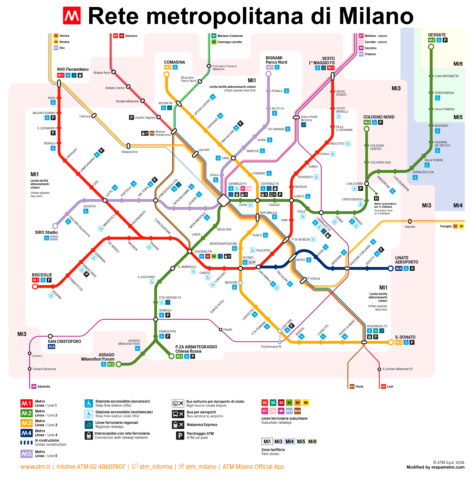Milan metro, locally known as “Metropolitana di Milano”, is the underground transportation system that operates in Milan, Italia.
This metro was inaugurated on 1 November 1964, and has five lines that cover a total length of 101 kilometres (62.8 miles) y 113 stations, connecting key points of the city and its surroundings. It is operated by the Azienda Trasporti Milanesi (ATM).
The network transports approximately 1.3 million passengers a day, being the most extensive and used in Italy.
Milan metro map
Below we show you the map of the Milan metro and its railway network. Click on the map to see it larger:

Official Web site
- Milan Metro official website: Milan Metro.
- Website with all the attractions of Milan.
Milan metro timetables
- Every day: 5:30h a 0:30h
- Fridays and Saturdays: 5:30h a 2:00h
Rates
Next, We show a table with the main prices in euros and their equivalent in US dollars (so that tourists have a better idea of prices):
| Type of Bill | Price in EUR | Price in USD |
|---|---|---|
| Single ticket | 2,20 € | 2,37 USD |
| daily ticket | 7,60 € | 8,19 USD |
| Bill of 3 days | 15,50 € | 16,70 USD |
| Notebook of 10 tickets | 19,50 € | 21,00 USD |
Other prices for special cards:
Special cards and discounts
| Card/Ticket Type | Description | Precio |
|---|---|---|
| MilanoCard 1 day | Includes unlimited access to public transportation for one day, a voucher 5 € for taxi, a free drink and discounts on tourist attractions. | 15,00 € (16,15 USD) |
| MilanoCard 3 days | Offers the same benefits but for three consecutive days. | 39,00 € (42,00 USD) |
| Discounts for children | Children under 14 years old travel for free on Milan public transport by showing an ID document. | Free |
| Billete Mi1-Mi3 | Allows unlimited travel within Mi1 to Mi3 zones per 90 minutes. Ideal for moving within the city and nearby suburbs. | 2,20 € (2,37 USD) |
| Airport Ticket | Combo tickets including Milan public transport and Malpensa Airport transfer service, Orio al Serio or Linate, offering a convenient and affordable option for travelers. | Varies depending on destination |
Combined airport tickets
Combo tickets including Milan public transport and Malpensa Airport transfer service, Orio al Serio or Linate, offering a convenient and affordable option for travelers.
| Airport | Shuttle service | Precio | Frequency | Ruta |
|---|---|---|---|---|
| Malpensa | Malpensa Shuttle | 10,00 € | Each 20-30 minutes | Malpensa – Central Station |
| Orio al Serio | Orio Shuttle | 10,00 € | Each 20-30 minutes | Orio al Serio – Central Station |
| Nuts | Linate Shuttle | 5,00 € | Each 20 minutes | Nuts – Central Station |
These combination tickets make it easy to travel between the airports and the center of Milan, combining the use of public transportation and direct bus service.
History of the subway

Milan metro, whose first line began to be built in 1957, The 1 November 1964. This line, known as M1 or red line, connect Lotto with Sesto Marelli. The engineers Franca Albini, Franco Helg and Antonio Piva led the design and construction was carried out by Società Trazione Elettrica Lombarda (SET).
In 1969, the second line was inaugurated, the M2 or green line, which is from Caiazzo to Cascina Gobba. ATM, Milan's public transport company, was in charge of its construction. This line was extended in 1981 to Gorgonzola and in 1985 hasta Gessate.
The third line, the M3 or yellow line, started operating 3 May 1990, just before the World Cup in Italy. Initially, connected Centrale with Duomo. In 1991, It extended to San Donato and in 2003 to Maciachini.
The M5 line, known as lilac line, The 10 February 2013. It was the first fully automated line. Originally, connected Bignami with Zara. In 2014, spread to Garibaldi and in 2015 at San Siro Stadium.
Finally, the M4 line, the blue line, The 26 November 2022, connecting Linate Aeroporto with Dateo. In 2023, extended to San Babila. This line was designed to improve the airport's connectivity with the city center..
History of the Milan metro map
The history of the Milan metro map dates back to the opening of the first line in 1964. In its beginnings, the M1 line, known as the red line, was the first to show a specific graphic design to facilitate user orientation. This line connected Lotto with Sesto Marelli and was distinguished by its red color on maps and signs..
Bob Noorda, a dutch graphic designer, was crucial in the development of the visual system of the Milan metro map. He created the iconic typeface and color schemes that are still used today..
Noorda worked with the architects Franco Albini, Franca Helg and Antonio Piva to make each station visually clear and recognizable, thus establishing a model for other metros in the world. Their work improved how these stations are used and influenced subway design worldwide..
In 1969, with the inauguration of the M2 line (verde), the map was expanded and took a more complex approach to displaying the lines and stations, and for this reason the color green was chosen to clearly differentiate it from the red line.
Over the years, new lines were added and multiple updates were made to the map. The M3 line (yellow) was inaugurated in 1990, followed by line M5 (lila) in 2013, which introduced the first fully automated section of the Milan metro.
In 2022, the M4 line was introduced (blue), which improved connectivity between Linate airport and the city center.
However, the influence of Bob Noorda and his collaborators continues to be present in each map update, that continues to evolve to better serve the millions of passengers who use the system daily.
Additional data
The M1 line passes by emblematic places such as the Duomo and the Castello Sforzesco, and the M2 line connects nightlife areas and the central station.
The M3 line connects the north and south, while the M5 facilitates access to the San Siro stadium. The recent opening of the M4 line (blue) connects Linate airport with the city center, significantly improving public transport connectivity.
This is a list of the most important sites in Milan and the closest metro stops.
- Milan Cathedral (Duomo, M1 y M3): The largest Gothic cathedral in Italy, with an impressive panoramic terrace.
- Vittorio Emanuele II Gallery (Duomo, M1 y M3): A historic shopping center with luxury shops and beautiful architecture.
- Teatro alla Scala (Duomo, M1 y M3): One of the most famous opera houses in the world, home of great productions.
- Sforzesco Castle (Cairoli, M1): 14th century fortress, houses museums and art exhibitions.
- Santa Maria delle Grazie and The Last Supper (Cadorna, M1 y M2): Renaissance church that houses Leonardo da Vinci's famous mural.
- Brera 's picture gallery (Lanza, M2): Art museum with masterpieces by Italian Renaissance artists.
- Sempione Park (Cadorna, M1 y M2): Central park next to the Sforzesco Castle, ideal for walks and relaxation.
- Monumental Cemetery (Monumental, M5): An open-air museum with sculptures and tombs of important historical figures.